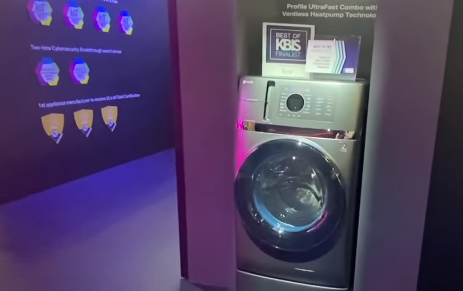The lid lock light flashing on your GE washer can be a cause for concern, but it’s crucial to remember that it’s the machine’s way of communicating a problem to you.
From minor issues that can be tweaked with a few adjustments to more severe problems that might require professional intervention, there could be several reasons for this flashing light.
This guide will walk you through what’s happening, common causes, and the potential repair costs involved.
How Do I Get my GE washing machine out of lock mode?
To get your GE washing machine out of lock mode, follow these simple steps:
Step 1. Stop the Cycle
Press the start/pause button to stop any running cycle. This is the first step to addressing GE washer lid lock problems.
Step 2. Unplug the Machine
Turn off the washer, then unplug it from the power source. Leave it disconnected for at least two minutes. This acts as a GE washer lid lock reset.
Step 3. Reconnect and Reset
Plug the machine back in and turn it on. If your GE washer lid lock light not on persists, try holding the start/pause button for 5 seconds to unlock.
Step 4. Check the Lid Lock Mechanism
Inspect the lid to ensure it isn’t jammed or misaligned. Closer inspection can address cases where the GE washer lid won’t lock or the GE washer door lock flashing.
Step. 5 Examine for Other Issues
If flashing lights continue, perform a GE washer flashing lights troubleshooting. Debris around the locking mechanism can cause malfunctions, so ensure the area is clean.
Step 6. Run a Test Cycle
Start a test cycle to confirm the problem is resolved. This also works for brands experiencing similar issues, like a Kenmore washing machine lid lock light flashing.
What are the Common Causes of Lid Lock Failure in GE Washers?
1. Dirt and Debris Buildup
A common cause of GE washer lid lock problems is dirt and debris accumulating in the locking mechanism. Over time, residue from water, lint, or detergent can block the latch from functioning properly.
This might prevent the lid from engaging or locking securely. Regular cleaning of the latch area can help avoid these kinds of issues.
If the GE washer lid won’t lock because of debris, a simple wipe-down might fix it.
2. Faulty Lid Lock Assembly
Wear and tear can lead to a malfunctioning lid lock assembly. This assembly controls the locking and unlocking of the washer lid. When damaged, the GE washer flashing lights troubleshooting process often points to this component as the culprit.
If the GE washer lid lock light not on is a problem, replacing the assembly is usually necessary.
Early detection can help save both time and costs.
3. Misaligned Washer Lid
An improperly aligned lid is another reason for failure. The washer lid must align perfectly with the sensor for the locking mechanism to activate. If the lid is bent or slightly out of place, it may cause the lock to malfunction.
Whirlpool washer lid lock light flashing and similar errors can occur in these cases.
Adjusting the lid manually or consulting a technician might resolve the issue.
4. Electrical Connection Problems
Faulty or loose wiring can disrupt how the lid lock works. A poor connection between the control board and the locking system might cause intermittent issues. Commonly, this is seen when the GE washer door lock flashing starts happening unexpectedly.
To fix this, the GE washer lid lock reset process or professional wiring repairs might be needed. This is often best handled by a trained technician.
5. Control Board Malfunctions
The control board manages all electronic operations, including the lid lock function.
If it gets damaged, the washer might fail to recognize when the lid is closed. This is a possible issue if your Kenmore washing machine lid lock light flashing symptoms persist even after resetting.
The control board may need replacing to restore proper function. This kind of repair can be more expensive but critical for long-term use.
GE Washer Lid Lock Light Flashing

1. Faulty Lid Lock Switch
Cause
The blinking lid lock light on your GE washer could indicate a faulty lid lock switch.
This is a critical component that ensures the lid is secure during the wash and spin cycles.
If the switch is malfunctioning, it may send false signals to the washer’s control system, causing the lid lock light to flash.
Solution:
Replacing the faulty lid lock switch can resolve this issue. Unplug the washer and locate the lid lock switch, usually beneath the lid area. Remove the old switch and replace it with a new one.
Ensure that the new switch is compatible with your GE washer model.
After replacement, plug the washer back in and run a test cycle. If the lid lock light no longer flashes, the problem has been fixed.
2. Malfunctioning Control Board
Cause
A malfunctioning control board could be a reason why the lid lock light on your GE washer is flashing.
The control board serves as the washer’s nerve center, coordinating its various functions. When it malfunctions, it can send incorrect signals, causing the lid lock light to flash erroneously.
Solution:
To resolve this issue, begin by unplugging the washer for about one minute to reset the control board.
If the problem persists, it may be necessary to replace the control board.
It’s highly recommended to seek the help of a professional technician for this task, as the control board is a complex component and incorrect handling could lead to further damage.
3. Damaged Lid Lock Assembly
Cause
The flashing light on your GE washer could be an indication of a damaged lid lock assembly.
This component is designed to ensure that the lid of the washer is securely closed during operation.
Over time, or due to rough handling, this assembly can become damaged, resulting in the flashing light as a warning signal.
Solution:
To resolve this issue, the defective lid lock assembly will need to be replaced. It is a delicate process, requiring you to disassemble part of your washer to reach the lid lock assembly.
If you’re not comfortable doing this, we strongly recommend contacting a professional appliance repair technician.
However, if you have experience with appliance repair, you can purchase a replacement part and install it yourself, following the manufacturer’s instructions.
4. Incorrectly Inserted Lid
Cause
The GE Washer’s lid lock light may flash if the lid is not correctly placed.
This is often due to the user hastily closing the lid or misaligning it during closure. The washer has a dedicated sensor that detects the proper seating of the lid.
If it senses that the lid is not correctly positioned, it triggers the lid lock light to flash as a warning signal.
Solution:
Resolving this issue is straightforward. Open the washer’s lid and close it again, ensuring that it fits squarely and firmly onto the body of the washer.
Listen for the characteristic click sound that indicates a secure lock. Take care not to slam the lid as it could damage the locking mechanism.
If the light continues to flash, it might be a sign of a faulty sensor, requiring professional assistance.
5. Wiring Issues
Cause
Wiring problems can be a common cause of the lid lock light flashing on your GE washer.
If the wiring connections are loose or the wires themselves are damaged, this could interrupt the signal from the lid lock to the control board, resulting in the flashing light.
Solution:
To rectify this issue, you will need to inspect and assess the condition of the wires connected to the lid lock and control board.
Make sure the connections are secure and there is no visible damage to the wires. If you find any damaged components, they need to be replaced.
It’s recommended to hire a professional technician for this task to ensure safety and accuracy.
6. Broken Lid Hinge
Cause
A broken lid hinge is a common issue that can lead to the washer lid lock light flashing.
This is because the lid hinge plays a critical role in signaling the lock mechanism to secure the lid during operation.
If the hinge is damaged, this communication may be disrupted, causing the washer to halt operation and the lid lock light to flash.
Solution:
The most effective solution for a broken lid hinge is replacement.
This process involves ordering an exact model match hinge from a reliable GE parts supplier, followed by careful removal of the faulty hinge and installation of the new one.
This task can be accomplished with basic tools, though a service technician might be needed if the issue persists after replacement.
7. Lid Lock Signal Error
Cause
The “Lid Lock Signal Error” is often indicative of an issue with the locking mechanism of the GE washer’s lid.
The error occurs when the washing machine is unable to detect that the lid is properly locked, possibly due to a faulty lid lock switch or a mismatch in the lid placement.
Solution:
To rectify the “Lid Lock Signal Error,” start by checking the lid’s alignment and ensuring it is properly closed.
If the error persists, it may be necessary to replace the lid lock switch. It’s recommended to consult a professional appliance repair technician to determine the exact issue and perform the necessary repairs.
8. Bad Capacitor
Cause
The lid lock light on your GE washer could be flashing due to a bad capacitor.
The capacitor stores electrical energy and sends it to the motor when the washer needs to spin.
If the capacitor is faulty, it won’t release enough power to the motor, causing the lid lock light to flash as a signal of this malfunction.
Solution
Addressing a faulty capacitor involves replacing it with a new one.
This task is best left to a professional appliance repair technician.
They have the necessary knowledge and tools to handle this task safely and effectively.
Make sure to unplug the washer before any work is done to prevent electrical shock.
9. Excessive Load Size
Cause
The flashing lid lock light on your GE washer may indicate an overload of laundry.
When the appliance detects that it is overloaded, it sends a signal, leading to the flashing of the lid lock light.
This happens because an excessive load can hinder the washer’s proper operation, potentially causing damage to its motor or drum.
Solution:
The solution is straightforward – simply remove some clothes from the washer to reduce the load.
Aim for a load that fills the washer to about three-quarters full, allowing enough free space for the clothes to move freely during the washing cycle.
This not only prevents the lid lock light from flashing but also ensures your clothes are cleaned properly and extends the washer’s lifespan.
10. Faulty Lid Strike
Cause
A common issue with GE washers is a faulty lid strike.
The lid strike is a component that engages with the lid lock to hold the lid securely closed during the wash cycle.
If the lid strike is damaged or malfunctions, it could lead to the lid lock light flashing, indicating that the machine recognizes the lid as not being properly secured.
Solution:
The solution to a faulty lid strike is typically replacing this part. Before replacement, ensure the lid strike is indeed the issue by inspecting it for visible damage or misalignment.
If confirmed, you can easily order a replacement part from a GE appliance parts supplier.
With the new lid strike in hand, refer to your washer’s manual for installation instructions, or seek the assistance of a professional if needed. This should rectify the flashing lid lock light issue.
11. Misaligned Lid Lock
Cause
A misaligned lid lock is a common issue that causes the lid lock light to flash on your GE washer.
This usually happens when the lid lock doesn’t properly align with the catch, preventing the lock from engaging.
It’s often due to everyday wear and tear or overuse, but it may also result from a faulty installation.
Solution:
To resolve this, first, inspect the alignment of the lid lock and the catch.
If they aren’t lining up correctly, gently adjust the position of the lid lock to align with the catch.
However, if the misalignment persists or the lid lock appears damaged, you might need to replace the lid lock assembly.
Remember, if you’re not confident doing this yourself, it’s best to call a professional appliance repair service to avoid any potential damage to your washer.
12. Electrical Power Surges
Cause
Electrical power surges are sudden, brief spikes in voltage that can interfere with the normal operation of your GE Washer.
This could result in erratic function, including unexpected triggering of the lid lock light.
Power surges can occur due to lightning strikes, problems with the power service, or the operation of high-powered electrical devices.
Solution:
To protect your washer from power surges, consider using a surge protector.
This device absorbs the excess voltage during a surge, preventing it from reaching your appliances.
In the event of frequent or severe surges, it might be advisable to consult with a professional electrician to assess your home’s electrical system and provide a more comprehensive solution.
13. Worn Out Lid Lock Solenoid
Cause
The GE washer lid lock light flashing could signify a worn-out lid lock solenoid.
This component is vital for securing the washing machine door during operation.
Over time, due to continuous use and wear, the solenoid may become damaged or stop functioning properly, leading to the light flashing signal on your washer.
Solution:
To address the issue of a worn-out lid lock solenoid, the solution is typically to replace the damaged part.
It’s advised to unplug the washer before starting the replacement process, for safety. You can then remove the old solenoid and replace it with a new one.
Ensure that the new solenoid is compatible with your GE washer model. After replacement, the lid lock light should stop flashing, indicating the washer is now functioning correctly.
14. Lid Lock Harness Failure
Cause
The Lid Lock Harness Failure in a GE washer can be caused by several factors.
One of the most common is the malfunctioning of the lid lock switch due to wear and tear over time.
Other reasons can include a faulty wiring connection or a damaged door lock coil.
Solution:
To fix the Lid Lock Harness Failure, start by examining the lid lock switch for any visible damages.
If the switch appears to be in good condition, check the wiring connections. Ensure they are secure and not corroded.
If the problem persists, consider replacing the door lock coil. Always remember to disconnect the washer from the power source before attempting any repairs.
15. Damaged Door Strike.
Cause
A damaged door strike can often cause the lid lock light to flash on your GE washer.
The door strike is part of the washer that the door latch locks onto when the door is closed.
If this component is damaged or broken, the washer may misinterpret the door being open, even when it’s closed, leading to the flashing light.
Solution:
The solution to a damaged door strike is typically a replacement.
It’s recommended to first visually inspect the door strike for any signs of damage. If the damage is evident, you’ll need to obtain a replacement part specific to your GE washer model.
These parts are generally easy to install by following the manufacturer’s instructions. If you’re not comfortable doing this yourself, you might want to consider hiring a professional.
How Much Would be The Cost to Repair the GE Washer Lid Lock Light Flashing?
1. Cost for Basic Troubleshooting
Fixing a GE washer lid lock light flashing can be simple and affordable. If the issue involves minor tweaks like a GE washer lid lock reset, it might cost you nothing.
Cleaning the lid lock area or aligning the lid to address ge washer lid lock problems could cost under $20 for basic tools or cleaning supplies.
Issues such as ge washer lid lock stuck or the lid not closing properly are often quick DIY solutions. This step-by-step resolution may save money and eliminate the need for professional service.
2. Cost of Replacing the Lid Lock Assembly
If the GE washer lid won’t lock due to a faulty lid lock assembly, a replacement might be needed. The part itself generally costs between $50 and $150, depending on the model.
This is common with similar issues like a Whirlpool washer lid lock flashing or the ge washer door lock flashing.
Labor prices can add another $75 to $150 if you hire a technician. Replacing the assembly is a practical choice for long-term reliability.
3. Repairing Electrical or Control Board Issues
When problems like the ge washer lid lock light not on or GE washer clicks then turns off arise, it could be an electrical issue. Repairs to the washer’s control board can range from $100 to $300.
This also applies to cases like ge washer flashing lights troubleshooting or maytag washer lid lock blinking.
A technician may need to inspect the wiring and connections to identify the root cause. While pricier, these repairs can restore your washer to optimal function.
4. Service for Sensor or Motor-Related Problems
A GE washer lid lock light flashing might also arise from fault sensors or motor issues. Parts like sensors cost around $50–$200, depending on complexity.
Similar problems can occur in speed queen washer wash spin and lid lock flashing 3 times. Professionals often charge $100 to $250 for labor addressing sensor or motor damage.
These repairs are recommended if the washer struggles to start or spins unevenly. It’s a worthwhile investment to ensure smooth operation.
5. Professional Diagnostic and Repair Costs
When multiple issues arise—such as ge washer lid lock problems combined with flashing lights—diagnostic fees can apply. Technicians may charge between $50 and $100 to assess the issue.
Advanced problems like ge washer lid lock light stuck or a Whirlpool washer lid lock light flashing might take longer to diagnose. The overall repair cost could range from $150 to $350, including parts and labor.
A professional inspection ensures a comprehensive solution, saving money over repeated quick fixes.
Conclusion
A flashing lid lock light on your GE washer can indicate a variety of potential problems, from an improperly closed lid to a malfunctioning lock mechanism.
It’s crucial to take notice of this warning sign as it could prevent further potential damage to the machine.
Always ensure the lid is securely closed before starting a washing cycle. If the issue persists, it might be a sign of a more serious problem, such as a faulty lid lock mechanism, which may require professional assistance.
Remember, regular maintenance and quick response to warning signs like these are key to prolonging the life and efficiency of your washer.


